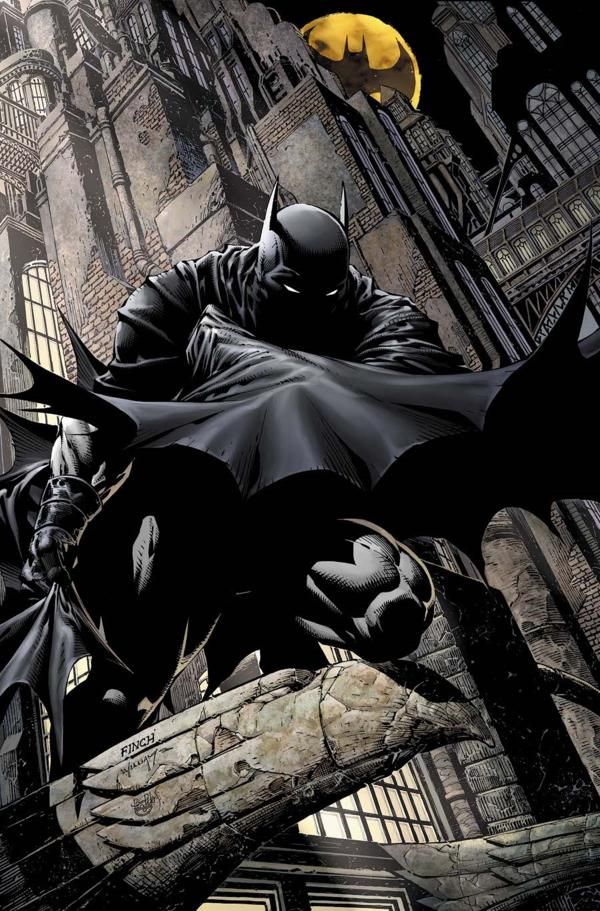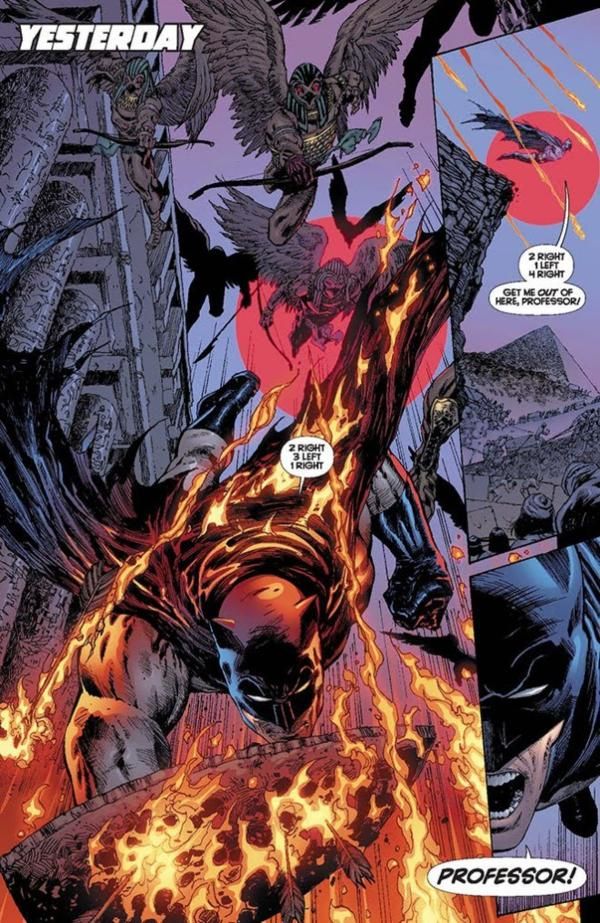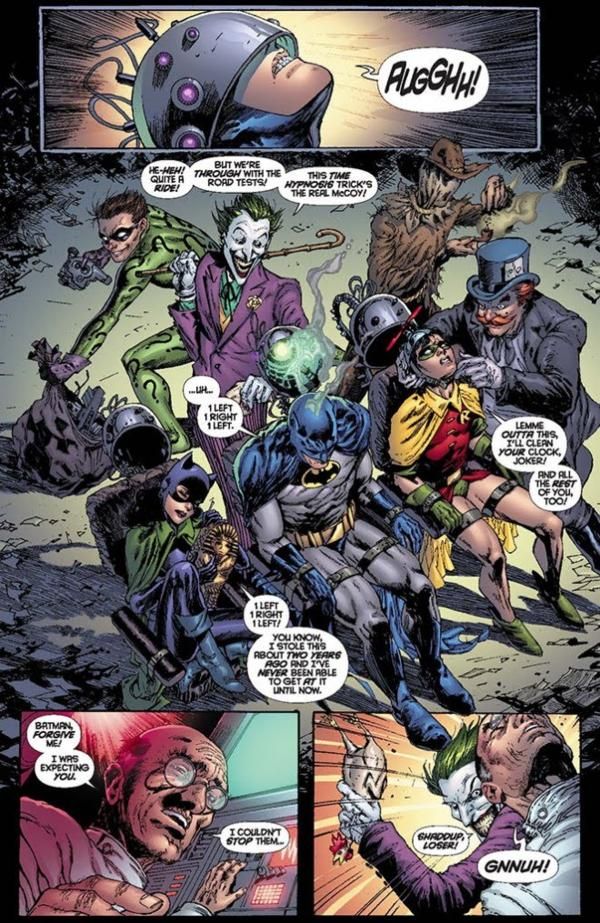Anniversary issues (at least the ones ending in double zeroes) tend to be a bit of a crap shoot, quality-wise. Luckily, this week's Batman #700 is a good one. Grant Morrison provides a densely told story that manages to be pretty much one cohesive tale while spanning three Batmen and four artists (plus an intriguing epilogue with four more Batmen and one more artist). It's a delightful total package and a worthy celebration of seven hundred issues of Batman.
As Morrison takes us through Batman's history, he also makes sure to include a little bit of DC's comic history, as well, like this opening, which references the Hawkman/Ancient Egypt connection.
Tony Daniel does very impressive work with the artwork of the opening to this time-spanning tale, which Morrison places in an intriguing time in Batman's life, the period between the campy Batman TV series and the grittier Denny O'Neil/Neal Adams' Batman. It's interesting to see characters practically evolve in front of your eyes, as Joker, in particular, seems to turn from Cesar Romero into the dark villain he would become in the 1970s.
This part of the story introduces three major parts of the story - Professor Charles Nichols (a real life Golden Age Batman supporting cast member who would send Batman and Robin to the past for adventures), the Joker's joke book (which, naturally, is itself a joke!) and the riddle/joke whose answer makes up the title of the story, "Time and the Batman."
The second part of the tale is perhaps the most disappointing, since this tale of modern Batman (Dick Grayson) and Robin (Damian Wayne) is not completely drawn by Frank Quitely, as originally advertised, but but by Quitely with Scott Kolins finishing off the last few page (here's hoping all is all right with Quitely, health-wise!). Morrison continues with his little trip through comic book history by having Dick (who, along with Damian, is celebrating a Batman comic book tradition - no crime allowed on the night Batman's parents were killed) using sticks similar to those he used to wield as Nightwing. Morrison follows up that blast from the past (which Quitely draws beautifully, always on the prowl for a stunning page of choreographed fighting) with a look to the future/past (continuity-wise future, actual comic release date-wise past) with the introduction of the Mutant gang that will later develop to become a major problem in Dark Knight Returns.
There is an exchange in this part of the story that I found especially impressive. When arriving on the scene of a "locked door" murder (the murder that ties together the first, second and third parts of the story), Dick encounters a police officer and enquires about the officer's child.
This scene is especially impressive because it achieves two things at once, both important...
1. It establishes what kind of Batman Dick Grayson is - he's the friendly Batman, the guy who'll remember that a cop's kid is in a wheelchair and ask about it.
2. It likely (and very subtly) gives the background for a villain who shows up in the third part of the story (a villain who is making his second appearance after first showing up in Batman #666).
The third part of the story is Damian Wayne's future Batman (which also debuted in Batman #666). This is an over-the-top and manic look at the crazy world of Gotham City in the future. Andy Kubert does strong work, although he appears to have made a major artistic error (well, I suppose it's not HIS fault as someone should have noticed it) as a character has a hole in their chest in the artwork BEFORE they are SUPPOSED to get a hole in the chest (and the dialogue makes it pretty clear that the hole is not meant to be there yet). It's an odd little error.
After bringing back Chief O'Hara to the comics in the first part (his first appearance in comics in years), Morrison follows that up with giving Terry McGinnis his first in-continuity comic book appearance, as well.
The story ends with a mysterious four-page epilogue by new DC Comics artist Dave Finch, who draws four future Batmen, beginning with Batman Beyond and ending with the Batman from Morrison's DC One Million storyline, with two other Batmen characters mixed in between (a page for each Batman) - this leads into the tagline for the ending - "No matter when, no matter where, no matter how dark" - that evokes the awesome ending to Last Rites, where Alfred relates his take on the power of Batman.
The always helpful Omar Karindu supplies who the middle two Batmen are. Here's Omar Karindu...
The DKR-esque Batman is a riff on the 1945 Batman story in Batman #26, where Brane (no last name) battles the armies of Saturnian warlord Fura in the year 3000 C.E. after being inspired by the legend of Batman and a time capsule containing the Declaration of Independence. The original story eventually reveals that Fura's armies are robot double sof the real Saturnians Batman/Brane behaves rather like a resistance fighter in the story, violating curfew and leaving taunting notes for Fura. Eventually, humanity is rallied and invades Saturn, freeing the real Saturnians and defeating Fura. The story makes Fura a Hitler analogue of sorts, even calling his original invasion a "blitzkrieg." Incidentally, Fura perishes when Brane blasts him in a man-on-man duel in space with spacesuits and jetpacks, sending Fura's frozen corpse hurtling off into the void.
Fura is mentioned by name in Batman #700, and the robots there resemble his Saturnian robots from the first Brane story.
The Euro-style Batman is the very similar character Brane Taylor, the Batman of the year 3051 from a 1951 story in Batman #67. Brane Taylor travels back to recruit Robin because his own era's Robin is injured. Taylor's lair in that tale is also "The Belfry," and sits atop a gleaming Buck Rogers sort of tower. (This was published some time ahead of Batman's 1960s and 1970s-era penthouse base.) In the story Taylor defeats crimelord Yerxa and his telepathic henchman the Dome, after which the original Batman travels through time to confuse Yerxa and keep Taylor's identity a secret. Taylor was also seen in Detective Comics #216. In this second tale, Taylor travels back from the year 3054 and returns the favor by posing as the original Batman to keep a visibly injured Bruce Wayne's secret safe from Vicki Vale.
Morrison and Finch have updated the aesthetics to a Phillip K. Dick-inspired bande dessinee.
Thanks for that!
The book then has a bunch of pin-ups and a look at the Bat-Cave courtesy of Freddie Williams III.
This was anniversary issue worth the wait!
Recommended.




